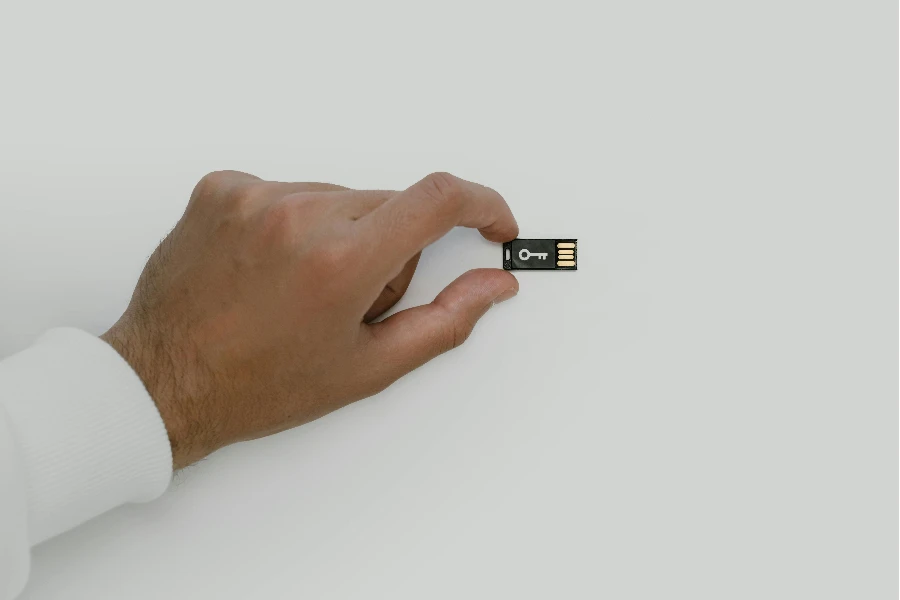As of 2024, the USB devices market is projected to grow significantly, with a valuation of USD 58 billion by 2030. This expansion is driven by the increasing need for efficient data storage and transfer solutions across various industries.
Table of Contents:
– USB Sticks Market Overview
– In-Depth Analysis of the USB Sticks Market
– Key Factors When Selecting USB Sticks
– Advanced Features and Innovations in USB Sticks
– Environmental Considerations and Sustainability
– Conclusion
USB Sticks Market Overview

The global market for USB devices was valued at USD 35.2 billion in 2023 and is projected to reach USD 58 billion by 2030, growing at a CAGR of 7.4% from 2023 to 2030. This growth is driven by the expanding use of digital devices and the rising demand for efficient data transfer and power delivery solutions. The USB devices market includes products like flash drives, external hard drives, keyboards, mice, printers, audio interfaces, and VR headsets.
The introduction of USB Type-C has revolutionized the market with its reversible connector, higher data transfer speeds, greater power delivery, and broader device compatibility. USB Type-C is becoming the standard for many new devices, including laptops, smartphones, and tablets. Additionally, the enhancement of USB Power Delivery (USB PD) allows for higher wattage power transfer, enabling the charging of larger devices through a USB connection.
In-Depth Analysis of the USB Sticks Market

The USB sticks market shows several key performance benchmarks and market share dynamics. USB 2.0 devices are expected to reach USD 29.4 billion by 2030 with a CAGR of 7.2%, while USB 3.0 devices are projected to grow at an 8.8% CAGR over the analysis period. Increasing demand for faster data transfer rates and higher power delivery capabilities is driving the demand for USB 3.0 and USB Type-C devices.
Economic factors such as the rise in remote work and digital learning have spurred demand for USB peripherals like webcams, external storage, and docking stations. Consumers are optimizing their home office setups, driving market growth. Additionally, the development of new USB standards, such as USB4, promises even faster data transfer speeds and better integration with other protocols, which is expected to drive further market growth.
Shifts towards sustainability are also influencing the market. There is growing demand for more energy-efficient USB devices and accessories, as consumers and industries seek greener technology solutions.
Regionally, the U.S. market was estimated at USD 9.6 billion in 2023, while China is forecasted to grow at an impressive 11.7% CAGR to reach USD 12.9 billion by 2030. Other key regions such as Japan, Canada, Germany, and the Asia-Pacific are also showing significant growth trends.
The competitive landscape of the global USB devices market includes major players such as ADATA Technology Co. Ltd, Corsair Memory Inc., Diodes Incorporated, Intel Corporation, Kingston Technology Corporation, and Western Digital Corporation. These companies drive innovation and maintain market presence through continuous technological advancements and strategic partnerships.
The USB sticks market is poised for robust growth, driven by technological advancements, increasing demand for efficient data transfer solutions, and shifts towards sustainability in consumer behavior.
Key Factors When Selecting USB Sticks

Choosing the right USB stick for your business involves considering various factors to meet your performance, capacity, compatibility, and budget requirements. Here are the key considerations:
Capacity and Storage Options
The storage capacity of a USB stick is a primary consideration. USB sticks range from 8GB to 2TB.
Usage Needs: For basic file transfers, an 8GB or 16GB USB stick may suffice. For larger files like videos or high-resolution images, consider 64GB, 128GB, or higher capacities.
Future-Proofing: Investing in a larger capacity USB stick can ensure it remains useful as your storage needs grow.
Portability vs. Capacity: Higher capacity USB sticks are often larger. Balance size and storage needs accordingly.
Data Transfer Speed
Data transfer speed is crucial, especially for business applications where efficiency is important.
USB Standards: USB sticks come in standards like USB 2.0, USB 3.0, and USB 3.1. USB 3.0 and above offer faster transfer rates. For example, USB 3.0 can transfer data at up to 5 Gbps, compared to USB 2.0’s 480 Mbps.
Read and Write Speeds: Premium models offer high read and write speeds, ideal for large files.
Real-World Performance: Check reviews and benchmarks to ensure the USB stick performs as advertised.
Build Quality and Durability
The physical build and durability of a USB stick are important, especially if it might be handled roughly.
Materials: USB sticks are made from plastic, metal, or both. Metal casings provide better protection.
Water and Shock Resistance: Some USB sticks are water-resistant and shockproof, essential for harsh environments.
Connector Protection: Look for USB sticks with retractable connectors or protective caps.
Security Features
Data security is crucial for sensitive business information.
Encryption: Many USB sticks offer built-in encryption. Hardware encryption is more secure than software encryption.
Password Protection: Some models include password protection to restrict access.
Biometric Security: Advanced models may feature fingerprint recognition for added security.
Compatibility and Connectivity
Ensure compatibility with various devices and operating systems for seamless data transfer.
Operating Systems: Check compatibility with your operating systems, such as Windows, macOS, Linux, or Android.
Device Compatibility: Some USB sticks have dual connectors, like USB-A and USB-C, to work with more devices.
OTG (On-The-Go): OTG-enabled USB sticks can connect directly to mobile devices.
Advanced Features and Innovations in USB Sticks

Technology advancements have made USB sticks more sophisticated with additional features.
Wireless USB Sticks
Wireless USB sticks allow data transfer without a physical connection.
Wi-Fi Connectivity: These sticks create a Wi-Fi network for multiple devices to connect wirelessly.
App Integration: Many come with apps for easy file management on mobile devices.
Battery Life: Check the battery life, as wireless sticks need charging.
USB Sticks with Integrated Software
Some USB sticks come with preloaded software to enhance functionality.
Backup Solutions: Integrated backup software ensures automatic data backups.
Data Recovery: Some models include software to recover lost or corrupted files.
File Management: Software can simplify file organization and transfer.
Customizable USB Sticks
Customization options allow businesses to tailor USB sticks to their brand and needs.
Branding: Custom USB sticks can feature company logos, ideal for promotional items.
Form Factor: Choose from various shapes and designs, like credit card-sized USB sticks.
Functionality: Some offer additional features like keychains, bottle openers, or LED indicators.
Environmental Considerations and Sustainability

Consider the environmental impact of USB sticks.
Eco-Friendly Materials
Manufacturers are using more sustainable materials.
Recycled Plastics: USB sticks made from recycled plastics reduce environmental impact.
Biodegradable Materials: Some are made from biodegradable materials.
Packaging: Look for minimalistic, recyclable packaging.
Energy Efficiency
Energy-efficient USB sticks consume less power, helping the environment and device battery life.
Low Power Consumption: These sticks extend the battery life of portable devices.
Energy Star Compliance: Some meet specific energy efficiency guidelines.
End-of-Life Recycling Programs
Many manufacturers offer recycling programs for USB sticks.
Manufacturer Programs: Check if the manufacturer has a recycling program.Local Recycling: Ensure USB sticks can be recycled at local electronic waste centers.
Conclusion
USB sticks are essential tools for data storage and transfer. By considering factors like capacity, speed, durability, security, and compatibility, businesses can choose USB sticks that meet their needs. Technological advancements and a focus on sustainability are making USB sticks more versatile and environmentally friendly.




